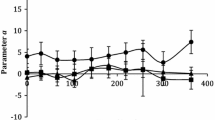Abstract
Tagatose browning in solutions might be unacceptable to certain products containing tagatose during processing and storage. The objective of this study was to evaluate the effects of temperature, pH, organic acids, and sulfites on tagatose browning in solutions. Tagatose showed the fastest browning reaction, followed by fructose, xylose, glucose, and sucrose. Tagatose browning was temperature and pH dependent. As temperature and pH increased, tagatose browning was increased. Tagatose browning was slow at temperatures lower than 80°C and pH of 5. Organic acids, such as ascorbic acid, citric acid, and lactic acid, activated tagatose browning. Sodium bisulfite and potassium metabisulfite inhibited tagatose browning, whereas sodium sulfite had no effect on the inhibition of tagatose browning. During storage at 25°C, tagatose browning did not occur regardless of the pH, tagatose concentration, and storage time. It was suggested that tagatose browning in solutions might be prevented by controlling the temperature and pH.
Similar content being viewed by others
Refrerences
Zehner LR. D-Tagatose as a low-calories carbohydrate sweetener and bulking agent. U.S. Patent 4,786,722 (1986)
Levin GV, Zehner LR, Saunder JP, Beadle JR. Sugar substitutes: Their energy values, bulk characteristics and potential health benefit. Am. J. Clin. Nutr. 62(Suppl.): 1161S–1168S (1995)
Nabors LO. Sweet choices: Sugar replacements for food and beverage. Food Technol. 56: 28–45 (2002)
Levin GV. Tagatose, the new GRAS sweetener and health product. J. Med. Food. 5: 23–26 (2002)
Cheetham PSJ, Wootton AN. Bioconversion of D-galactose into D-tagatose. Enzyme Microb. Tech. 15: 105–108 (1993)
Oh DK. Tagatose: Properties, applications, and biotechnological process. Appl. Microbiol. Biotechnol. 76: 1–8 (2007)
Roh HJ, Kim SY, Kim SS, Oh DK. Physicochemical properties of a low calorie sweetener, tagatose. Korean J. Food Sci. Technol. 31: 24–29 (1999)
Liversey G, Brown JC. D-Tagatose is the bulk sweetener with zero energy determined in rat. J. Nutr. 126: 1601–1609 (1996)
Bertelsen H, Jensen BB, Buemann B. D-Tagatose-a novel lowcalorie bulk sweetener with prebiotic properties. World Rev. Nutr. Diet. 52: 98–109 (1999)
Leaker HN, Tensen BB. D-Tagatose gas low small intestinal digestibility but high large intestinal fermentability in pigs. J. Nutr. 128: 1002–1009 (1999)
Leaker HN, Jensen BB, Hojsgaard S. In vitro fermentation pattern of Dtagatose is affected by adaptation of the microbial from the gastrointestinal tract of pig. J. Nutr. 130: 1772–1779 (2000)
Rulis AM. Agency response letter GRAS notice No. GRN 000078. Available from: http://www.cfsan.fda.gov/-rda/opa-g78.html. Accessed Aug. 12, 2008.
Skytte UP. Tagatose. pp. 262–294. In: Sweeteners and Sugar Alternatives in Food Technology. Mitchell H (ed). Blackwell Publishing, Ames, IA, USA (2006)
Damhert. Damhert NV/SA-natural product-tagatose. Available from: http://www.damhert.be/producten.cfm?cat=12&catomschrijiving=tagatose. Accessed Nov. 19, 2009.
Ryu SY, Roh HJ, Noh BS, Kim SY, Oh DK, Lee WJ, Yoon JR, Kim SS. Optimization of Maillard reactions of tagatose and glycine model solution by applying response surface methodology. Korean J. Food Sci. Technol. 35: 914–917 (2003)
Ryu SY, Roh HJ, Noh BS, Kim SY, Oh DK, Lee WJ, Yoon JR, Kim SS. Effect of temperature and pH on the non-enzymatic browning reaction of tagatose–glycine model system. Food Sci. Biotechnol. 12: 675–679 (2003)
Cho IH, Lee S, Jun HR, Roh HR, Kim YS. Comparison of volatile Maillard reaction products from tagatose and other reducing sugars with amino acids. Food Sci. Biotechnol. 19: 431–438 (2010)
Dobbs CM, Bell LN. Storage stability of tagatose in buffer solutions of various compositions. Food Res. Int. 43: 382–386 (2010)
Luecke KJ, Bell LN. Thermal stability of tagatose in solution. J. Food Sci. 75: C346–C351 (2010)
Grant LD, Bell LN. Physical and chemical stability of tagatose powder. J. Food Sci. 77: C308–C313 (2012)
Eggleston G, Vercellotti JR. Degradation of sucrose, glucose and fructose on concentrated aqueous solutions under constant pH conditions at elevated temperature. J. Carbohyd. Chem. 19: 1305–1318 (2000)
Ryu SY, Roh HJ, Noh BS, Kim SY, Oh DK, Lee WJ, Yoon JR, Kim SS. Effect of various sugars including tagatose and their molar concentration on the Maillard browning reaction. Korean J. Food Sci. Technol. 35: 898–904 (2003)
Yang R, Shin DB. A study on the amino–carbonyl reaction. Korean J. Food Sci. Technol. 12: 88–95 (1980)
Wolfrom ML, Kashimura N, Horton D. Factors affecting the Maillard browning reaction between sugar and amino acids. Studies on the nonenzymatic browning of dehydrated orange juice. J. Agr. Food Chem. 22: 796–800 (1974)
Kim WJ, Chun YH, Sung HS. Evaluation and prediction of color change of sugar-glycine mixture by Maillard reaction. Korean J. Food Sci. Technol. 18: 306–311 (1986)
Shallenberger RS, Birch GG. Sugar Chemistry. The AVI Publishing Company, Inc., Westport, CT, USA. pp. 74–76 (1975)
Lee CH, Han BJ, Kim NY, Lim JK, Kim BC. Studies on the browning reaction of sugar derivative sweeteners. Korean J. Food Sci. Technol. 23: 52–56 (1991)
Wong DWS. Mechanism and Theory in Food Chemistry. Van Nostrand Reinhold, New York, NY, USA. pp. 105–115 (1989)
Barnes HM, Kaufman CW. Industrial aspects of the browning reaction. Ind. Eng. Chem. 39: 1167–1170 (1947)
Burton HS, McWeeny DJ. Nonenzymic browning reaction: Consideration of sugar stability. Nature 197: 266–268 (1963)
Burton HS, McWeeny DJ, Bilycliffe DO. Nonenzymic browning: Development of chromophores in the glucose-glycine and sucroseglycine system. J. Food. Sci. 28: 631–639 (1963)
Author information
Authors and Affiliations
Corresponding author
Rights and permissions
About this article
Cite this article
Kwon, S.Y., Baek, H.H. Effects of temperature, pH, organic acids, and sulfites on tagatose browning in solutions during processing and storage. Food Sci Biotechnol 23, 677–684 (2014). https://doi.org/10.1007/s10068-014-0092-6
Received:
Revised:
Accepted:
Published:
Issue Date:
DOI: https://doi.org/10.1007/s10068-014-0092-6




